INSTITUT SUPERIEUR D'ANTHROPOLOGIE
INSTITUTE OF ANTHROPOLOGY
ONLINE COURSES / COURS A DISTANCE
WINTER TERM : JANUARY 2015
REGISTER NOW
INDE – 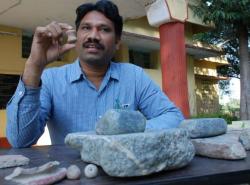 Pazzur - The Department of Archaeology has identified a rare pre-historic period habitation near Pazzur village of Thipparthi mandal in Nalgonda district. Retired senior caretaker, A. Bhanu Murthy and Technical Assistant P. Nagaraju visited the site, locally called as Pati, couple of days ago and found some antiquities like ornamental beads, spool, couple of grinding stones, red ware and black ware pottery, decorated red ware and part of rim of a storage pot at the site. Speaking to The Hindu, Mr. Murthy, said that it would be the first pre-historic site in Nalgonda, which probably belonged to 1st and 2nd century AD. Stating that they have also found one-foot square light weighted brick at the site, Mr. Murthy further said that the farmers unknowingly had damaged most part of the site spread in about 25 acres because they have been cultivating the area since more than four decades. As they have also found two temples of Siva and Rama belonging to 12th Century AD just 500 meters away from this site inside the present Pazzur vilage, he said that they are strongly believing that there was habitation at this site some 2,000 years ago. He further said that the current Pazzur village might have moved from Pati, the pre-historic site, to present location after 2nd century AD for various reasons. “We would be able to get all the truth about the site only by excavating it, he opined.
Pazzur - The Department of Archaeology has identified a rare pre-historic period habitation near Pazzur village of Thipparthi mandal in Nalgonda district. Retired senior caretaker, A. Bhanu Murthy and Technical Assistant P. Nagaraju visited the site, locally called as Pati, couple of days ago and found some antiquities like ornamental beads, spool, couple of grinding stones, red ware and black ware pottery, decorated red ware and part of rim of a storage pot at the site. Speaking to The Hindu, Mr. Murthy, said that it would be the first pre-historic site in Nalgonda, which probably belonged to 1st and 2nd century AD. Stating that they have also found one-foot square light weighted brick at the site, Mr. Murthy further said that the farmers unknowingly had damaged most part of the site spread in about 25 acres because they have been cultivating the area since more than four decades. As they have also found two temples of Siva and Rama belonging to 12th Century AD just 500 meters away from this site inside the present Pazzur vilage, he said that they are strongly believing that there was habitation at this site some 2,000 years ago. He further said that the current Pazzur village might have moved from Pati, the pre-historic site, to present location after 2nd century AD for various reasons. “We would be able to get all the truth about the site only by excavating it, he opined.
http://www.thehindu.com/news/national/andhra-pradesh/prehistoric-site-spotted-in-nalgonda/article6713151.ece
ROYAUME UNI – 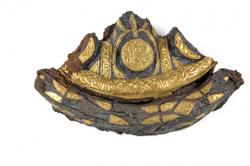 Bedale - Archaeologists have revealed hacked-off silver ingots engraved with the symbol of the cross and a large sword pommel featuring animal and gold leaf decorations by “highly skilled” Anglo-Saxon craftsmen on one of the most important hoards found in the north of England.Having raised £50,000 to buy the Bedale Hoard, the Yorkshire Museum asked the York Archaeological trust to examine the Viking treasures. Conservators found wood and textile samples and tiny cuts used to test the purity of its silver during the late 9th or early 10th centuries.“The hoard is really making us think about this part of Yorkshire in the Viking Period in a different way,” says Natalie McCaul, the Curator of Archaeology at York Museums Trust.“It contains objects from across the Viking world including rare and unique pieces such as the huge silver neckring – one of the largest examples of its type ever found.“It is only now that the hoard has been conserved that we can see its real beauty and the incredible craftsmanship involved in creating some of the artefacts.“The Anglo-Saxon sword pommel is probably the stand-out piece. This is something that has been plundered by the Vikings, and the conservation has meant we can now see the fantastic and delicate gold leaf patterns much more clearly and in some cases for the first time.”Experts admit a large element of mystery surrounding the Christian symbols on several of the 29 ingots, and believe the textile fragments could suggest the sword was wrapped in a cloth within a hoard buried in a wooden box.Inlaid with plaques of gold foil bearing the animal decorations consistent with 9th century English style, the pommel includes four oval ring mounts from the grip of a sword which could also have made use of six tiny, dome-headed gold rivets.The hoard, which has gone back on public display in the Yorkshire Museum’s Medieval Gallery, was found by metal detectorists in May 2012.
Bedale - Archaeologists have revealed hacked-off silver ingots engraved with the symbol of the cross and a large sword pommel featuring animal and gold leaf decorations by “highly skilled” Anglo-Saxon craftsmen on one of the most important hoards found in the north of England.Having raised £50,000 to buy the Bedale Hoard, the Yorkshire Museum asked the York Archaeological trust to examine the Viking treasures. Conservators found wood and textile samples and tiny cuts used to test the purity of its silver during the late 9th or early 10th centuries.“The hoard is really making us think about this part of Yorkshire in the Viking Period in a different way,” says Natalie McCaul, the Curator of Archaeology at York Museums Trust.“It contains objects from across the Viking world including rare and unique pieces such as the huge silver neckring – one of the largest examples of its type ever found.“It is only now that the hoard has been conserved that we can see its real beauty and the incredible craftsmanship involved in creating some of the artefacts.“The Anglo-Saxon sword pommel is probably the stand-out piece. This is something that has been plundered by the Vikings, and the conservation has meant we can now see the fantastic and delicate gold leaf patterns much more clearly and in some cases for the first time.”Experts admit a large element of mystery surrounding the Christian symbols on several of the 29 ingots, and believe the textile fragments could suggest the sword was wrapped in a cloth within a hoard buried in a wooden box.Inlaid with plaques of gold foil bearing the animal decorations consistent with 9th century English style, the pommel includes four oval ring mounts from the grip of a sword which could also have made use of six tiny, dome-headed gold rivets.The hoard, which has gone back on public display in the Yorkshire Museum’s Medieval Gallery, was found by metal detectorists in May 2012.
http://www.culture24.org.uk/history-and-heritage/archaeology/art511237-archaeologists-rethink-viking-yorkshire-as-hoard-highlights-plundered-anglo-saxon-sword
ROYAUME UNI – 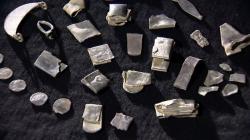 Gaulcross - Together with a team of archaeologists, Mr McPherson discovered a hoard of Roman and Pictish silver in a farmer's field. It has been hailed as the most northern of its kind in Europe. Until now, the specific location of the discovery in March 2013 has been a closely guarded secret. But BBC Scotland can reveal it was found at Gaulcross, near Fordyce, in Aberdeenshire.More than 100 pieces of silver were unearthed, including coins, brooches and bracelets. Most of the objects were found in pieces, or folded in to small parcels. The hoard is now being researched and catalogued by experts at National Museums Scotland. Dr Gordon Noble, senior lecturer in department of archaeology, said: "The north east of Scotland is very rich in its heritage and we've been working on a number of Pictish sites, including our work at Rhynie, which appears to be an early royal centre of the Picts."At Rhynie, we're actually finding metal working moulds, exactly the kind of items that would be used to make some of the items that we've found in the hoard here.''The team has returned to Gaulcross several times since the initial discovery in 2013. They want to be certain that no remaining metal pieces have been unearthed after the field has been ploughed.
Gaulcross - Together with a team of archaeologists, Mr McPherson discovered a hoard of Roman and Pictish silver in a farmer's field. It has been hailed as the most northern of its kind in Europe. Until now, the specific location of the discovery in March 2013 has been a closely guarded secret. But BBC Scotland can reveal it was found at Gaulcross, near Fordyce, in Aberdeenshire.More than 100 pieces of silver were unearthed, including coins, brooches and bracelets. Most of the objects were found in pieces, or folded in to small parcels. The hoard is now being researched and catalogued by experts at National Museums Scotland. Dr Gordon Noble, senior lecturer in department of archaeology, said: "The north east of Scotland is very rich in its heritage and we've been working on a number of Pictish sites, including our work at Rhynie, which appears to be an early royal centre of the Picts."At Rhynie, we're actually finding metal working moulds, exactly the kind of items that would be used to make some of the items that we've found in the hoard here.''The team has returned to Gaulcross several times since the initial discovery in 2013. They want to be certain that no remaining metal pieces have been unearthed after the field has been ploughed.
http://www.bbc.com/news/uk-scotland-north-east-orkney-shetland-30551671
ROYAUME UNI –  Malmesbury Abbey -It is a view only the birds normally get to see of one of the West’s most famous churches. But archaeologists who normally go below ground have taken to the skies with a drone camera to attempt to solve one of the puzzles from the darkest chapters of our local history. The Wiltshire Archaeology Field Group have embarked on a major project to try to find out why so many of the church buildings in the county bear the scars of the English Civil War. The churches, like Malmesbury Abbey pictured here, are among the few buildings still around from the great battles of the 1640s, and would have been commandeered by soldiers using their thick stone walls as protection. But many churches bear dozens of marks of damage from gunshot, grape shot and even cannons. Malmesbury Abbey is perhaps the most-damaged, with hundreds of pock-marks a couple of inches wide that appear to have been made by muskets. “There are so many marks and they are all over the church and go so high up that one theory has been that the winning soldiers, after taking the town, fired their guns up at the church walls in victory,” said Tony Hack, one of the co-directors of the team from WAFG who took these remarkable pictures. “The idea behind the surveys is to map them for the first time, and to get such a detailed examination of them using photogrammetry and 3D realisation that we will even be able to work out where the person who fired the shots was standing. That way, it will be easier to tell if they were the damage in a battle, or by someone just firing at the wall from below,” he added. The project covers the whole spectrum of archaeology from the civil war, from battlefield sites to military camp surveys and artefact analysis, to build up a complete picture of the civil war in the county, and its legacy today.
Malmesbury Abbey -It is a view only the birds normally get to see of one of the West’s most famous churches. But archaeologists who normally go below ground have taken to the skies with a drone camera to attempt to solve one of the puzzles from the darkest chapters of our local history. The Wiltshire Archaeology Field Group have embarked on a major project to try to find out why so many of the church buildings in the county bear the scars of the English Civil War. The churches, like Malmesbury Abbey pictured here, are among the few buildings still around from the great battles of the 1640s, and would have been commandeered by soldiers using their thick stone walls as protection. But many churches bear dozens of marks of damage from gunshot, grape shot and even cannons. Malmesbury Abbey is perhaps the most-damaged, with hundreds of pock-marks a couple of inches wide that appear to have been made by muskets. “There are so many marks and they are all over the church and go so high up that one theory has been that the winning soldiers, after taking the town, fired their guns up at the church walls in victory,” said Tony Hack, one of the co-directors of the team from WAFG who took these remarkable pictures. “The idea behind the surveys is to map them for the first time, and to get such a detailed examination of them using photogrammetry and 3D realisation that we will even be able to work out where the person who fired the shots was standing. That way, it will be easier to tell if they were the damage in a battle, or by someone just firing at the wall from below,” he added. The project covers the whole spectrum of archaeology from the civil war, from battlefield sites to military camp surveys and artefact analysis, to build up a complete picture of the civil war in the county, and its legacy today.
http://www.westerndailypress.co.uk/PICTURED-Damage-celebrating-English-Civil-War/story-25747307-detail/story.html
QATAR –  Doha -According to the latest archaeological findings, Doha’s origins go back 200 years, but the ongoing infrastructure within the region could impact on the excavations. From a seashore fishing vilage and pearl diving community, Doha has grown to become the hub of infrastructure within Qatar, including deep tunnelling excavations for Doha Metro and vast road building around the Expressway. In a pioneering effort to find the origins of modern Doha, archaeologists have found evidence that the city was founded 200 years ago in the early 19th century. Evidence of early habitation around the Qubib Mosque and near Musherib in the heart of Doha, a few houses, each with a kitchen and two rooms and an alley have been found, along with coins, glass, animal and botanical remains imported pottery, incense burners and merchant’s weights, The Peninsula reports.. The excavation site next to the Qubib Mosque lies between the Fardan Centre and the FANAR Centre, on the other side of Bank Street (Grand Hamad Avenue) from Souq Waqif. In 2013, another excavation was conducted in Musherib.First appearing on a map in 1823, Doha was said to have been founded after Bida’ (now parkland on the other side of the Emiri Diwan), which colonial British sources thought was founded around 1801, Carter explained.
Doha -According to the latest archaeological findings, Doha’s origins go back 200 years, but the ongoing infrastructure within the region could impact on the excavations. From a seashore fishing vilage and pearl diving community, Doha has grown to become the hub of infrastructure within Qatar, including deep tunnelling excavations for Doha Metro and vast road building around the Expressway. In a pioneering effort to find the origins of modern Doha, archaeologists have found evidence that the city was founded 200 years ago in the early 19th century. Evidence of early habitation around the Qubib Mosque and near Musherib in the heart of Doha, a few houses, each with a kitchen and two rooms and an alley have been found, along with coins, glass, animal and botanical remains imported pottery, incense burners and merchant’s weights, The Peninsula reports.. The excavation site next to the Qubib Mosque lies between the Fardan Centre and the FANAR Centre, on the other side of Bank Street (Grand Hamad Avenue) from Souq Waqif. In 2013, another excavation was conducted in Musherib.First appearing on a map in 1823, Doha was said to have been founded after Bida’ (now parkland on the other side of the Emiri Diwan), which colonial British sources thought was founded around 1801, Carter explained.
http://www.constructionweekonline.com/article-31890-doha-dig-reveals-city-is-200-years-old/
INDE – 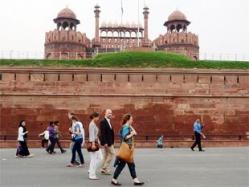 Dehli - Replying to a question, Minister of State for Culture Mahesh Sharma said, scientific clearance work done by ASI at Red Fort has revealed the evidence of a water channel and system of fountains of Mehtab Bagh, which was originally built by Mughal Emperor Shajahan. The British had destroyed Mehtab Bagh during their rule and flattened the area completely, he added.
Dehli - Replying to a question, Minister of State for Culture Mahesh Sharma said, scientific clearance work done by ASI at Red Fort has revealed the evidence of a water channel and system of fountains of Mehtab Bagh, which was originally built by Mughal Emperor Shajahan. The British had destroyed Mehtab Bagh during their rule and flattened the area completely, he added.
http://economictimes.indiatimes.com/news/politics-and-nation/archaeological-survey-of-india-has-found-evidence-of-water-channel-at-red-fort-government/articleshow/45606698.cms?
GRECE - 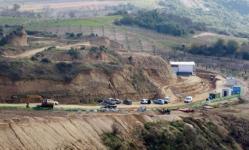 Amphipolis - The Ministry of Culture has announced that according to the results of the geophysical scan of Kasta Hill [pictured] in Amphipolis, where the enigmatic ancient Greek tomb has been located, the human intervention has be rather limited. The team of scientists primarily used electrical tomography techniques – and to a lesser extent a ground penetrating radar (GPR) – in order to examine human intervention on the hill. As it transpires, the man-made embankment is only a minor portion of the hill. The geophysical survey and mapping of Kasta Hill began on the 11th of November and is carried out whenever the weather conditions permit. Scientists expect the scan to highlight areas of interest for future archeological investigation.
Amphipolis - The Ministry of Culture has announced that according to the results of the geophysical scan of Kasta Hill [pictured] in Amphipolis, where the enigmatic ancient Greek tomb has been located, the human intervention has be rather limited. The team of scientists primarily used electrical tomography techniques – and to a lesser extent a ground penetrating radar (GPR) – in order to examine human intervention on the hill. As it transpires, the man-made embankment is only a minor portion of the hill. The geophysical survey and mapping of Kasta Hill began on the 11th of November and is carried out whenever the weather conditions permit. Scientists expect the scan to highlight areas of interest for future archeological investigation.
http://www.tovima.gr/en/article/?aid=661736
CROATIE –  Split - Better known for its sun-kissed coastline and islands, the focus on popular Croatian tourism region Central Dalmatia was on the interior on December 19, 2014, as the first stretch of the region's Roman roads was opened between Kurtovići and Klapavice, in a ceremony which was attended by officials from neighbouring Klis and Dugopolje. The 2 kilometre stretch is the first to be opened under the initiative, which plans to make the region's rich Roman heritage more accessible to tourists. The ancient Roman city of Salona just outside Split was an extremely important base prior to its sacking, while Diocletian's Palace is the former retirement home of the Roman Emperor of the same name. It is the most popular tourist attraction in the Dalmatian capital of Split.
Split - Better known for its sun-kissed coastline and islands, the focus on popular Croatian tourism region Central Dalmatia was on the interior on December 19, 2014, as the first stretch of the region's Roman roads was opened between Kurtovići and Klapavice, in a ceremony which was attended by officials from neighbouring Klis and Dugopolje. The 2 kilometre stretch is the first to be opened under the initiative, which plans to make the region's rich Roman heritage more accessible to tourists. The ancient Roman city of Salona just outside Split was an extremely important base prior to its sacking, while Diocletian's Palace is the former retirement home of the Roman Emperor of the same name. It is the most popular tourist attraction in the Dalmatian capital of Split.
http://www.digitaljournal.com/life/travel/first-roman-road-in-central-dalmatia-opened-near-split-croatia/article/421616?